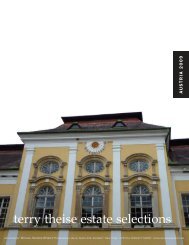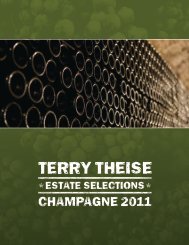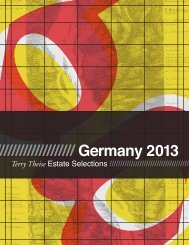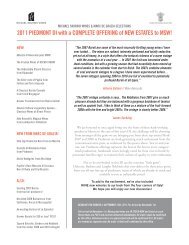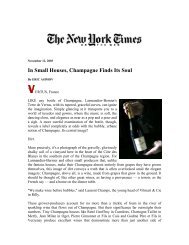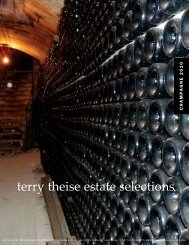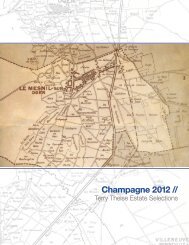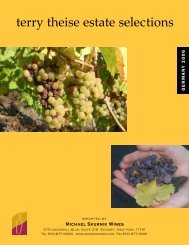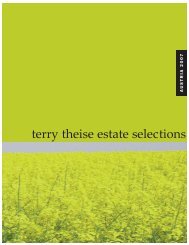View 2013 Champagne Catalog - Michael Skurnik Wines
View 2013 Champagne Catalog - Michael Skurnik Wines
View 2013 Champagne Catalog - Michael Skurnik Wines
You also want an ePaper? Increase the reach of your titles
YUMPU automatically turns print PDFs into web optimized ePapers that Google loves.
mean exactly what they say, but we should at least bear in<br />
mind, when someone says how dry his wine is because he<br />
uses little or no dosage, that his base wine may have had a<br />
dollop of its own sweetness.<br />
Another gratifying thing was to see the growing sense<br />
of activity among the growers in the region itself. There’s<br />
the 3rd annual tasting with the theme “Winegrowers<br />
continue to revolt in the name of <strong>Champagne</strong>’s terroirs!”<br />
being held in Aÿ. Eighteen growers will take part, a virtual<br />
who’s-who of the hotties: Agrapart, Bérèche, Chartogne,<br />
Doquet, Geoffroy, Goutorbe, Laherte, Tarlant among<br />
others. Such a thing would have been unheard-of back<br />
in 1997, but now there’s an ignition of enlightenment.<br />
And <strong>Champagne</strong>, forever the most moribund of regions,<br />
is now among the most interesting.<br />
And there are more growers than ever on the U.S.<br />
market, 178 in 2011. That’s a lot of growers, pal. And<br />
the market-share for this cunning little category is 3.43%.<br />
Still, when I started this Quixotic thing in 1997, the share<br />
was 0.62%, so we have traveled a distance.<br />
I opened my existing <strong>Champagne</strong> catalogue and saw<br />
I’d written a desperate note; “Must we talk about residual<br />
sugar any more?” This is the inevitable downside of the<br />
Champenoise entering the current.<br />
This year was the year-of-the-dosage-trials, as growers<br />
let me further in to their process. I am touched by the<br />
collegial gestures of trust. I also have strong opinions<br />
on this question, or better said, one strong opinion. It’s<br />
simple and seems self-evident, until you contemplate how<br />
infrequently it is applied.<br />
Wine should be balanced. Different wines are<br />
balanced with different amounts of sweetness, and a few<br />
are balanced with little or none. The 4g/l of a Lallement<br />
Rosé would simply not work with Margaine’s Rosé, but<br />
it’s perfect for Lallement. Other examples abound.<br />
But why does this even need to be said? This is<br />
kindergarten wine understanding! But, sadly, a commonsense<br />
proposition like this one is mortally threatened by<br />
an obtuse and dogmatic insistence that drier is always<br />
preferable. And this idea is just stupid enough to be<br />
speciously seductive, and a lot of otherwise sharp cookies<br />
were seduced.<br />
So I was hugely encouraged when two growers shared<br />
their dosage trials with me, because these were two who<br />
seemed at risk of slipping down the rabbit hole whereby<br />
dryness was forced into their wines as proof of purity. I<br />
watched them return to reasonableness, and was happy.<br />
Less dosage is not always better. It doesn’t make<br />
your wine more honest, more pure, more transparent,<br />
more sophisticated, or more honorable; it just makes it<br />
more dry. Among the many dubious things we owe the<br />
big <strong>Champagne</strong> houses is that they’ve poisoned the well<br />
by making their commercial bottlings treacly-sweet in order to<br />
mask the deficiencies of the base product, or because they<br />
presume their “market” wants the wines sweet. And so we all<br />
believe that less sweetness is more desirable. First we let them<br />
dupe us, and then we duped ourselves.<br />
Less sweetness is more desirable under two<br />
and only two circumstances in <strong>Champagne</strong>: one, the<br />
wine tastes better that way; two, the drinker happens<br />
to honestly dislike sweetness in his <strong>Champagne</strong>. (We’ll<br />
leave aside for the moment the sweetness he accepts in<br />
myriad other things...). You cannot determine these<br />
things until you taste. Can you imagine someone saying<br />
“I ate a lot of fritos when I was a kid, and now I just<br />
can’t stand the taste of salt in anything.” Somehow it’s only<br />
sugar that inspires these theological disputes.<br />
Tom Stevenson recently published an article in<br />
World Of FineWine in which he said – someone finally<br />
said – that <strong>Champagne</strong>s with less than 6 grams-per-liter<br />
(g.l.) wouldn’t age well. I’ll revisit this subject when I<br />
write about the many shades of “Brut” a little later on.<br />
I am also willing to accept the truism about<br />
the blender’s art. Blending is certainly an art when<br />
done well, though this doesn’t address the matter of<br />
whether and when it’s necessary.The fact is there isn’t<br />
a single decent Récoltant who sells the Négoce his best<br />
grapes! Rather the opposite. And for any single Négoce<br />
who truly practices the “blender’s art” there are two dozen<br />
who’re dumping a lot of mediocre fruit into one big tub.<br />
There’s a fragile balance of power in <strong>Champagne</strong>. The<br />
Houses need the growers to supply them grapes. Many are<br />
abjectly dependent on their network of cute little paysannes.<br />
The growers claim to need the Houses to act as flagships,<br />
furthering the good image of <strong>Champagne</strong> throughout the<br />
world. Publicly the Houses put on a tolerant face as regards<br />
the growers. Privately... well, you see.<br />
One grower with whom we discussed the “ethics”<br />
of marketing grower-<strong>Champagne</strong> said “We ourselves<br />
are really not in a position to criticize the Grandes<br />
Marques, because they break new ground for <strong>Champagne</strong>,<br />
open new markets, and eventually we get our small share<br />
of it too. We’d never have the ability to do that on our<br />
own; we’re too small. Look, we taste around, we know<br />
very well how mediocre their wines are, but we need them.”<br />
“It sounds like you also need us,“ I observed,” to fight<br />
this fight for you, to say the things you know but can’t say.”<br />
“Exactly,” came the reply.<br />
<strong>Champagne</strong> Fleury was threatened with a<br />
lawsuit because the label on their Rosé bore a certain<br />
resemblance to Perrier-Jouët’s Fleur de <strong>Champagne</strong><br />
(never mind the Fleury was a Rosé, in a clear bottle,<br />
unlikely to be mistaken for PJ’s wine except by the colorblind),<br />
thus invoking trademark-protection issues, PJ’s<br />
having effectively trademarked flowers apparently. I can<br />
only imagine how threatened they must have felt by the<br />
100 cases of Fleury Rosé rampaging through the American<br />
market. But still, zero-tolerance and all that. Around the<br />
same time I learned that Clicquot was suing a sparkling<br />
wine producer in Tasmania who had the temerity to use<br />
a yellow label on their fizz. Perhaps the Houses should<br />
collectively trademark VOWELS, so that the growers<br />
would have to call their wine “Chmpgn.”<br />
Introduction<br />
3



